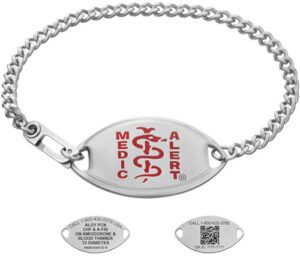Many people with Alzheimer’s disease wander away from their home or caregiver. As the caregiver, you need to know how to limit wandering and prevent the person from becoming lost. This will help keep the person safe and give you greater peace of mind.
First Steps
Try to follow these steps before the person with Alzheimer’s disease wanders:
- Make sure the person carries some kind of ID or wears a medical bracelet. If the person gets lost and can’t communicate clearly, an ID will let others know about his or her illness. It also shows where the person lives.
- Let neighbors and the local police know that the person with Alzheimer’s tends to wander. Ask them to alert you immediately if the person is seen alone and on the move.
- Place labels in garments to aid in identification.
- Keep an article of the person’s worn, unwashed clothing in a plastic bag to aid in finding him or her with the use of dogs.
- Keep a recent photograph or video recording of the person to help police if he or she becomes lost.
Tips to Prevent Wandering
Here are some tips to help prevent the person with Alzheimer’s from wandering away from home:
- Keep doors locked. Consider a keyed deadbolt, or add another lock placed up high or down low on the door. If the person can open a lock, you may need to get a new latch or lock.
- Use loosely fitting doorknob covers so that the cover turns instead of the actual knob.*
- Place STOP, DO NOT ENTER, or CLOSED signs on doors.
- Divert the attention of the person with Alzheimer’s disease away from using the door by placing small scenic posters on the door; placing removable gates, curtains, or brightly colored streamers across the door; or wallpapering the door to match any adjoining walls.
- Install safety devices found in hardware stores to limit how much window can be opened.
- Install an “announcing system” that chimes when the door opens.
- Secure the yard with fencing and a locked gate.
- Keep shoes, keys, suitcases, coats, hats, and other signs of departure out of sight.
- Do not leave a person with Alzheimer’s who has a history of wandering unattended.
For more tips on home safety, see “Home Safety for People with Alzheimer’s Disease,” www.nia.nih.gov/alzheimers/publication/home-safety-people-alzheimers-disease.
*Due to the potential hazard they could cause if an emergency exit is needed, locked doors and doorknob covers should be used only when a caregiver is present.
Information taken from the National Institute on Aging, part of the National Institutes of Health www.nia.nih.gov/alzheimers/topics/caregiving




